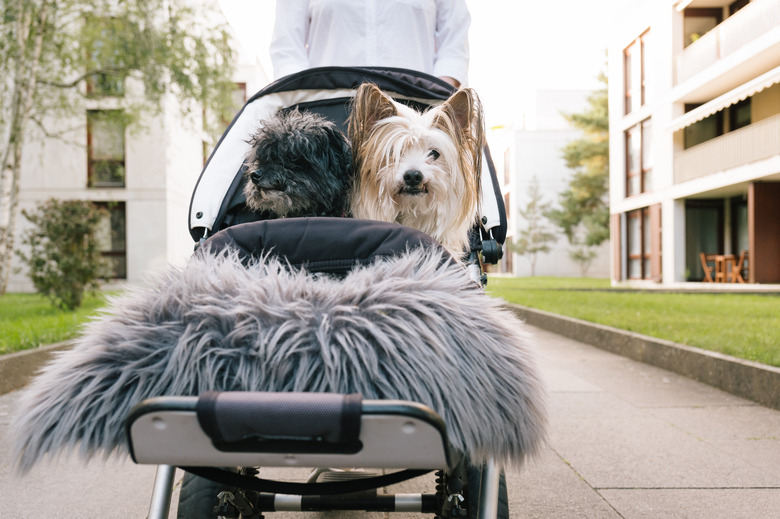Treating Flat Feet In Dogs
When a dog has orthopedic issues, it can affect everything from their mobility to their mood, and it can affect the pet parent in the form of worries and anxiety. Flat feet in dogs can do both, and it can be especially distressing for a pet parent to see, as their pet's feet might appear distorted. However, this condition is treatable. The best outcome depends not only on the cause of the dog's flat feet but also on timely and appropriate veterinary care. If your dog develops flat feet, don't delay getting in touch with your veterinarian.
What is flat feet in dogs?
Flat feet in dogs is an orthopedic condition resulting primarily from genetic predisposition or trauma. The condition is more formally known as carpal subluxation or carpal laxity. There are two abnormalities that fall under this condition (carpal hyperextension and carpal flexion), but this article focuses on hyperextension affecting the front foot. Carpal hyperextension is the most common cause of flat feet in dogs.
Visually, carpal laxity or carpal subluxation looks like your dog is walking on the whole bottom part of their leg instead of just their paws. In reality, they are walking on the carpal joint (which is comparable to the wrist in humans), which gives them the "flat-footed" appearance that you see. Usually, both front limbs are affected, but in rare cases, it might only happen in one limb.
What causes flat feet in dogs?
In addition to trauma (the most likely cause of carpal abnormalities), carpal hyperextension can also be the result of a developmental abnormality in young puppies. It can also manifest as a degenerative condition in older, large-breed dogs.
Carpal subluxation
In the canine leg, the carpus is similar to the human wrist. In a dog suffering from carpal subluxation, this joint is partially dislocated. Over time, the dog starts to walk on the partially dislocated carpus, looking like they have flat feet. Carpal subluxation occurs more often in males than females and is more prevalent in certain dog breeds.
Puppies affected by carpal issues usually show signs between the ages of 6 and 12 weeks, although symptoms can appear later. If the carpal issue was due to trauma, there can be pain and swelling. When these carpal issues are conformation or developmental related, there is generally no pain or swelling, but even if the dog is not in pain, they might have trouble walking. The condition can also happen to puppies kept in small cages or crates in pet stores or shelters.
Carpal hyperextension usually results from an accident or a fall, such as jumping from a substantial height. Immediate lameness generally occurs along with carpal swelling and the flat-footed appearance of walking on the carpal joint. Take your dog to the emergency veterinarian if they exhibit carpal hyperextension symptoms. The veterinarian must take X-rays of the affected leg, with further X-rays necessary if other trauma is suspected.
Treatment for dogs with flat feet
Treatment for flat feet depends on the underlying cause and how seriously the flat-footed dog is affected in terms of both mobility and quality of life. The veterinarian might recommend pain medication, splinting of the affected leg(s), or surgery depending on the severity of the condition.
For puppies with developmental deficits, treatment often calls for physical therapy to strengthen leg muscles, controlled exercise on surfaces with good traction, and possibly wrapping of the carpus. Your veterinarian might also prescribe a special diet or nutritional supplements. Most puppies with carpal laxity have a good prognosis if treated early and appropriately, and they can grow up to be healthy dogs with normal legs and feet.
For trauma-related carpal hyperextension, your pet will receive pain medication. While pain management and splinting the leg can help, it's likely your dog will require surgery and an extended period of recuperation, especially if it is a severe case. They might not regain much if any range of motion in their carpus after recovery because the surgery (carpal arthrodesis) fuses the wrist joint. Despite this, surgery will allow the canine a more normal, pain-free gait in the long term.
How to prevent flat feet in dogs
Prevention is always worth a pound of cure — or the thousands of dollars you might spend treating a carpal hyperextension injury. Since falls cause the majority of carpal hyperextension injuries, keep windows and doors in upper-level parts of your home secured and dogproof. If you have a steep staircase in your home, limit your dog's access to the upper floor. When taking your dog out for a run, avoid steep slopes, embankments, and uneven ground. With puppies, avoid keeping them on slippery surfaces or in too-small crates and make sure they get the right amount of exercise.
Is flat feet in dogs bad?
While flat feet in dogs is usually not life-threatening, it should still be regarded as a serious medical concern because it can profoundly affect the dog's mobility and quality of life. In many cases, carpal subluxation can be cured or minimized, but this depends on both the severity of the carpal laxity as well as the pet caregiver seeking prompt veterinary attention and complying with treatment plans.
The bottom line
Flat feet in dogs, known as carpal laxity or carpal subluxation, can result from a variety of causes, from a developmental abnormality to a traumatic injury. The condition can cause pain, mobility problems, or quality of life issues, but it is highly treatable. Depending on cause and severity, treatment options include anti-inflammatory pain medication, exercise modification, splinting, or surgery. Most dogs with flat feet have an excellent prognosis when the condition is addressed promptly and appropriately. If you suspect your dog has carpal subluxation, contact your veterinarian as soon as possible.



